Variations in FINN Emissions of Particulate Matters and Associated Carbonaceous Aerosols from Remote Sensing of Open Biomass Burning over Northeast China during 2002–2016
Abstract
1. Introduction
2. Observation Data and Analysis Methods
3. Results and Discussion
3.1. Temporal Variation of Emissions Averaged over NE Region
3.1.1. Monthly Variations of Emissions
3.1.2. Inter-Annual Variations of Emissions
3.2. Spatial Variations of Emissions in the NE Region
3.2.1. 15-Year Averages of Emissions
3.2.2. Differences of High PM Emissions between 2003 and 2016
3.2.3. Changes of OC/BC Emission Ratio
3.2.4. Spatial Distribution of Inter-Annual Emission Variations
3.3. Key Meteorological Drivers in Emission Changes
4. Conclusions
Author Contributions
Funding
Conflicts of Interest
References
- Crutzen, P.J.; Heidt, L.E.; Krasnec, J.P.; Pollock, W.H.; Seiler, W. Biomass burning as a source of atmospheric gases CO, H2, N2O, NO, CH3Cl and COS. Nature 1979, 282, 253–256. [Google Scholar] [CrossRef]
- Cofer, W.R.; Koutzenogii, K.P.; Kokorin, A.; Ezcurra, A. Biomass Burning Emissions and the Atmosphere. In Sediment Records of Biomass Burning and Global Change; Clark, J.S., Cachier, H., Goldammer, J.G., Stocks, B., Eds.; Springer: Berlin/Heidelberg, Germany, 1997; pp. 189–206. ISBN 978-3-642-63881-7. [Google Scholar]
- Zong, Z.; Wang, X.; Tian, C.; Chen, Y.; Qu, L.; Ji, L.; Zhi, G.; Li, J.; Zhang, G. Source apportionment of PM2.5 at a regional background site in North China using PMF linked with radiocarbon analysis: Insight into the contribution of biomass burning. Atmos. Chem. Phys. 2016, 16, 11249–11265. [Google Scholar] [CrossRef]
- Bond, T.C.; Streets, D.G.; Yarber, K.F.; Nelson, S.M.; Woo, J.-H.; Klimont, Z. A technology-based global inventory of black and organic carbon emissions from combustion. J. Geophys. Res. 2004, 109, D14203. [Google Scholar] [CrossRef]
- Crutzen, P.J.; Andreae, M.O. Biomass Burning in the Tropics: Impact on Atmospheric Chemistry and Biogeochemical Cycles. Science 1990, 250, 1669–1678. [Google Scholar] [CrossRef] [PubMed]
- Cachier, H.; Liousse, C.; Buat-Menard, P.; Gaudichet, A. Particulate content of savanna fire emissions. J. Atmos. Chem. 1995, 22, 123–148. [Google Scholar] [CrossRef]
- Deng, X.; Tie, X.; Wu, D.; Zhou, X.; Bi, X.; Tan, H.; Li, F.; Jiang, C. Long-term trend of visibility and its characterizations in the Pearl River Delta (PRD) region, China. Atmos. Environ. 2008, 42, 1424–1435. [Google Scholar] [CrossRef]
- Pope, C.A.; Dockery, D.W. Health effects of fine particulate air pollution: Lines that connect. J. Air Waste Manag. Assoc. 2006, 56, 709–742. [Google Scholar] [CrossRef] [PubMed]
- Heal, M.R.; Kumar, P.; Harrison, R.M. Particles, air quality, policy and health. Chem. Soc. Rev. 2012, 41, 6606–6630. [Google Scholar] [CrossRef] [PubMed]
- Zhang, H.; Hu, J.; Qi, Y.; Li, C.; Chen, J.; Wang, X.; He, J.; Wang, S.; Hao, J.; Zhang, L. Emission characterization, environmental impact, and control measure of PM2.5 emitted from agricultural crop residue burning in China. J. Clean. Prod. 2017, 149, 629–635. [Google Scholar] [CrossRef]
- Haywood, J.M.; Ramaswamy, V. Global sensitivity studies of the direct radiative forcing due to anthropogenic sulfate and black carbon aerosols. J. Geophys. Res. 1998, 103, 6043–6058. [Google Scholar] [CrossRef]
- Jacobson, M.Z. Control of fossil-fuel particulate black carbon and organic matter, possibly the most effective method of slowing global warming. J. Geophys. Res. 2002, 107, 4410. [Google Scholar] [CrossRef]
- Ichoku, C.; Kahn, R.; Chin, M. Satellite contributions to the quantitative characterization of biomass burning for climate modeling. Atmos. Res. 2012, 111, 1–28. [Google Scholar] [CrossRef]
- Duncan, B.N.; Martin, R.V.; Staudt, A.C.; Yevich, R.; Logan, J.A. Interannual and seasonal variability of biomass burning emissions constrained by satellite observations. J. Geophys. Res 2003, 108, 4040. [Google Scholar] [CrossRef]
- Van der Werf, G.R.; Randerson, J.T.; Giglio, L.; Collatz, G.J.; Kasibhatla, P.S.; Arellano, A.F., Jr. Interannual variability in global biomass burning emissions from 1997 to 2004. Atmos. Chem. Phys. 2006, 6, 3423–3441. [Google Scholar] [CrossRef]
- Bossioli, E.; Tombrou, M.; Kalogiros, J.; Allan, J.; Bacak, A.; Bezantakos, S.; Biskos, G.; Coe, H.; Jones, B.T.; Kouvarakis, G. Atmospheric composition in the Eastern Mediterranean: Influence of biomass burning during summertime using the WRF-Chem model. Atmos. Environ. 2016, 132, 317–331. [Google Scholar] [CrossRef]
- Streets, D.G.; Yarber, K.F.; Woo, J.-H.; Carmichael, G.R. Biomass burning in Asia: Annual and seasonal estimates and atmospheric emissions. Glob. Biogeochem. Cycles 2003, 17, 1099. [Google Scholar] [CrossRef]
- Sahu, L.K.; Sheel, V.J. Spatio-temporal variation of biomass burning sources over South and Southeast Asia. J. Atmos. Chem. 2014, 71, 1–19. [Google Scholar] [CrossRef]
- Zhou, Y.; Xing, X.; Lang, J.; Chen, D.; Cheng, S.; Wei, L.; Wei, X.; Liu, C. A comprehensive biomass burning emission inventory with high spatial and temporal resolution in China. Atmos. Chem. Phys. 2017, 17, 2839–2864. [Google Scholar] [CrossRef]
- Li, X.; Wang, S.; Duan, L.; Hao, J.; Li, C.; Chen, Y.; Yang, L. Particulate and Trace Gas Emissions from Open Burning of Wheat Straw and Corn Stover in China. Environ. Sci. Technol. 2007, 41, 6052–6058. [Google Scholar] [CrossRef] [PubMed]
- Wu, J.; Kong, S.; Wu, F.; Cheng, Y.; Zheng, S.; Yan, Q.; Zheng, H.; Yang, G.; Zheng, M.; Liu, D.; et al. Estimating the open biomass burning emissions in central and eastern China from 2003 to 2015 based on satellite observation. Atmos. Chem. Phys. 2018, 18, 11623–11646. [Google Scholar] [CrossRef]
- Li, J.; Li, Y.; Bo, Y.; Xie, S. High-resolution historical emission inventories of crop residue burning in fields in China for the period 1990–2013. Atmos. Environ. 2016, 138, 152–161. [Google Scholar] [CrossRef]
- Zheng, X.; Liu, X.; Zhao, F.; Duan, F.; Yu, T.; Cachier, H. Seasonal characteristics of biomass burning contribution to Beijing aerosol. Sci. China Ser. B Chem. 2005, 48, 481–488. [Google Scholar] [CrossRef]
- Duan, F.; Yu, L.T.; Cachier, H. Identification and estimate of biomass burning contribution to the urban aerosol organic carbon concentrations in Beijing. Atmos. Environ. 2004, 38, 1275–1282. [Google Scholar] [CrossRef]
- Wang, Q.; Cao, J.; Shen, Z.; Tao, J.; Xiao, S.; Luo, L.; He, Q.; Tang, X. Chemical characteristics of PM2.5 during dust storms and air pollution events in Chengdu, China. Particuology 2013, 11, 70–77. [Google Scholar] [CrossRef]
- Yang, Y.; Chan, C.; Tao, J.; Lin, M.; Engling, G.; Zhang, Z.; Zhang, T.; Su, L. Observation of elevated fungal tracers due to biomass burning in the Sichuan Basin at Chengdu city, China. Sci. Total Environ. 2012, 431, 68–77. [Google Scholar] [CrossRef] [PubMed]
- Zhao, H.M.; Zhang, X.L.; Zhang, S.C.; Chen, W.W.; Tong, D.Q.; Xiu, A.J. Effects of Agricultural Biomass Burning on Regional Haze in China: A Review. Atmosphere 2017, 8, 88. [Google Scholar] [CrossRef]
- Cheng, Z.; Wang, S.; Fu, X.; Watson, J.G.; Jiang, J.; Fu, Q.; Chen, C.; Xu, B.; Yu, J.; Chow, J.C.; et al. Impact of biomass burning on haze pollution in the Yangtze River delta, China: A case study in summer 2011. Atmos. Chem. Phys. 2014, 14, 4573–4585. [Google Scholar] [CrossRef]
- Yamaji, K.; Li, J.; Uno, I.; Kanaya, Y.; Irie, H.; Takigawa, M.; Komazaki, Y.; Pochanart, P.; Liu, Y.; Tanimoto, H.; et al. Impact of open crop residual burning on air quality over Central Eastern China during the Mount Tai Experiment 2006 (MTX2006). Atmos. Chem. Phys. 2010, 10, 7353–7368. [Google Scholar] [CrossRef]
- Chen, W.W.; Tong, D.Q.; Dan, M.; Zhang, S.C.; Zhang, X.L.; Pan, Y.P. Typical atmospheric haze during crop harvest season in northeastern China: A case in the Changchun region. J. Environ. Sci. 2017, 54, 101–113. [Google Scholar] [CrossRef] [PubMed]
- Huang, X.; Li, M.; Friedli, H.R.; Song, Y.; Chang, D.; Zhu, L. Mercury Emissions from Biomass Burning in China. Environ. Sci. Technol. 2011, 45, 9442–9448. [Google Scholar] [CrossRef] [PubMed]
- Kong, F.H.; Li, X.Z.; Zhao, S.L.; Yin, H.W. Research advance in forest restoration on the burned blanks. J. For. Res. 2003, 14, 180–184. [Google Scholar] [CrossRef]
- Lawrence, C.C.K.; Avelino, F.A.; John, L.M. Investigating the haze transport from 1997 biomass burning in Southeast Asia: Its impact upon Singapore. Atmos. Environ. 2001, 35, 2723–2734. [Google Scholar] [CrossRef]
- Nie, W.; Ding, A.J.; Xie, Y.N.; Xu, Z.; Mao, H.; Kerminen, V.M.; Zheng, L.F.; Qi, X.M.; Huang, X.; Yang, X.Q.; et al. Influence of biomass burning plumes on HONO chemistry in eastern China. Atmos. Chem. Phys. 2015, 15, 1147–1159. [Google Scholar] [CrossRef]
- Wang, Y.; Zhuang, G.S.; Tang, A.H.; Yuan, H.; Sun, Y.L.; Chen, S.; Zheng, A.H. The ion chemistry and the source of PM2.5 aerosols in Beijing. Atmos. Environ. 2005, 39, 3771–3784. [Google Scholar] [CrossRef]
- Zhang, J.J.; Cui, M.M.; Fan, D.; Zhang, D.S.; Lian, H.X.; Yin, Z.Y.; Li, J. Relationship between haze and acute cardiovascular, cerebrovascular, and respiratory diseases in Beijing. Environ. Sci. Pollut. Res. 2015, 22, 3920–3925. [Google Scholar] [CrossRef] [PubMed]
- Zhao, H.M.; Tong, D.Q.; Gao, C.Y.; Wang, G.P. Effect of dramatic land use change on gaseous pollutant emissions from biomass burning in Northeastern China. Atmos. Res. 2015, 153, 429–436. [Google Scholar] [CrossRef]
- Korontzi, S.; McCarty, J.; Loboda, T.; Kumar, S.; Justice, C. Global distribution of agricultural fires in croplands from 3 years of Moderate Resolution Imaging Spectroradiometer (MODIS) data. Glob. Biogeochem. Cycles 2006, 20, GB2021. [Google Scholar] [CrossRef]
- Friedl, M.A.; Sullamenashe, D.; Tan, B.; Schneider, A.; Ramankutty, N.; Sibley, A.; Huang, X.M. MODIS Collection 5 global land cover: Algorithm refinements and characterization of new datasets. Remote. Sens. Environ. 2010, 114, 168–182. [Google Scholar] [CrossRef]
- Wiedinmyer, C.; Akagi, S.K.; Yokelson, R.J.; Emmons, L.K.; Al-Saadi, J.A.; Orlando, J.J.; Soja, A.J. The Fire INventory from NCAR (FINN): A High Resolution Global Model to Estimate the Emissions from Open Burning. Geosci. Model Dev. 2011, 4, 625–641. [Google Scholar] [CrossRef]
- Val Martin, M.; Heald, C.L.; Ford, B.; Prenni, A.J.; Wiedinmyer, C. A decadal satellite analysis of the origins and impacts of smoke in Colorado. Atmos. Chem. Phys. 2013, 13, 7429–7439. [Google Scholar] [CrossRef]
- Jiang, X.; Wiedinmyer, C.; Carlton, A.G. Aerosols from Fires: An Examination of the Effects on Ozone Photochemistry in the Western United States. Environ. Sci. Technol. 2012, 46, 11878–11886. [Google Scholar] [CrossRef] [PubMed]
- Reddington, C.L.; Spracklen, D.V.; Artaxo, P.; Ridley, D.A.; Rizzo, L.V.; Arana, A. Analysis of particulate emissions from tropical biomass burning using a global aerosol model and long-term surface observations. Atmos. Chem. Phys. 2016, 16, 11083–11106. [Google Scholar] [CrossRef]
- Giglio, L.; Csiszar, I.; Justice, C.O. Global distribution and seasonality of active fires as observed with the Terra and Aqua Moderate Resolution Imaging Spectroradiometer (MODIS) sensors. J. Geophys. Res. 2015, 111, 17–23. [Google Scholar] [CrossRef]
- Cahoon, D.R., Jr.; Stocks, B.J.; Levine, J.S.; Cofer, W.R., III; Pierson, J.M. Satellite analysis of the severe 1987 forest fires in northern China and southeastern Siberia. J. Geophys. Res. 1994, 99, 18627–18638. [Google Scholar] [CrossRef]
- Levine, J.S.; Cofer, W.R., III; Cahoon, D.R., Jr.; Winstead, E.L. Biomass Burning: A Driver for Global Change. Environ. Sci. Technol. 1995, 29, 120A–125A. [Google Scholar] [CrossRef]
- Hallquist, M.; Wenger, J.C.; Baltensperger, U.; Rudich, Y.; Simpson, D.; Claeys, M.; Dommen, J.; Donahue, N.M.; George, C.; Goldstein, A.H.; et al. The formation, properties and impact of secondary organic aerosol: Current and emerging issues. Atmos. Chem. Phys. 2009, 9, 5155–5236. [Google Scholar] [CrossRef]
- Novakov, T.; Andreae, M.O.; Gabriel, R.; Kirchstetter, T.W.; Mayol-Bracero, O.L.; Ramanathan, V. Origin of carbonaceous aerosols over the tropical Indian Ocean: Biomass burning or fossil fuels? Geophys. Res. Lett. 2000, 27, 4061–4064. [Google Scholar] [CrossRef]
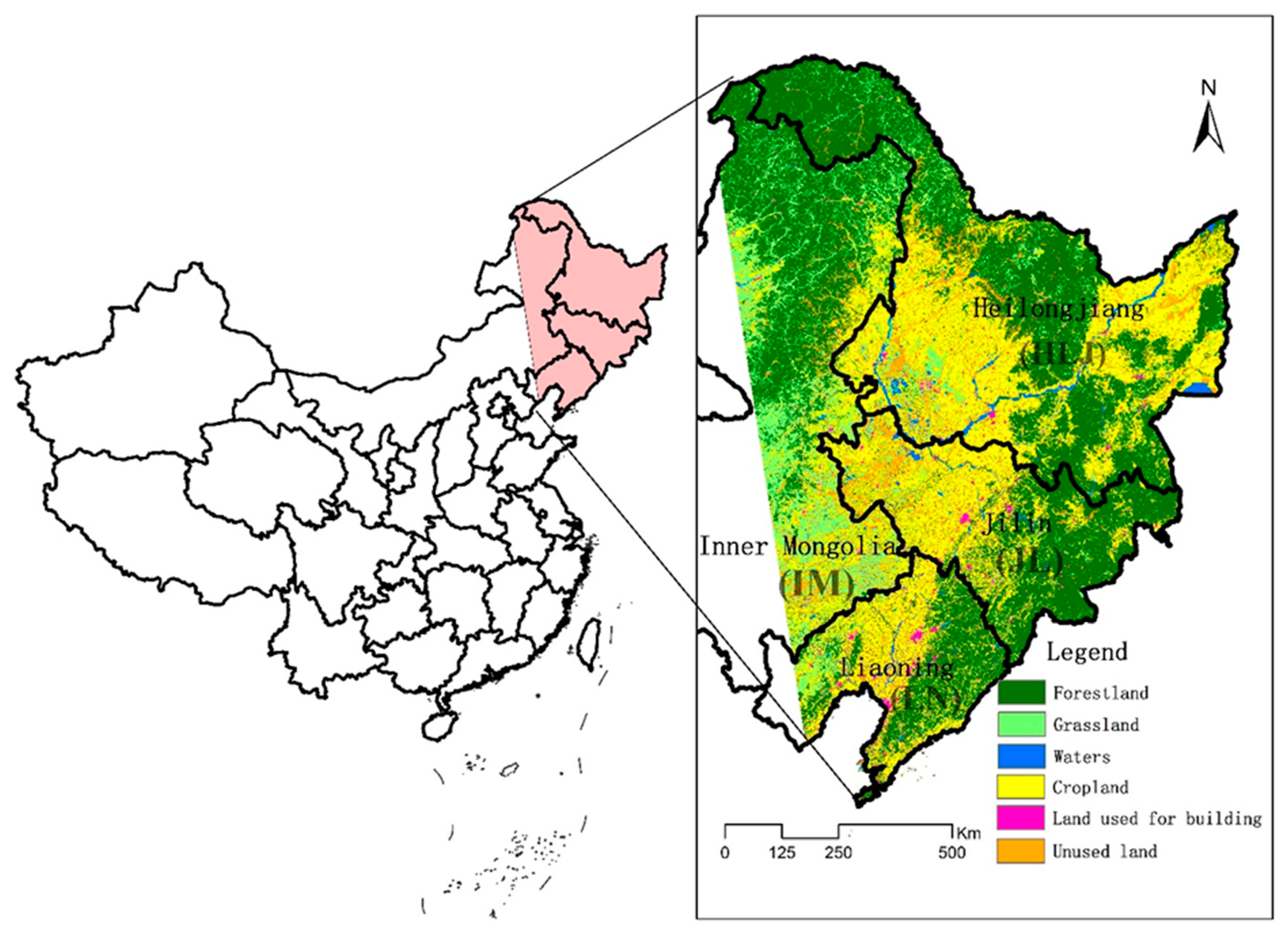
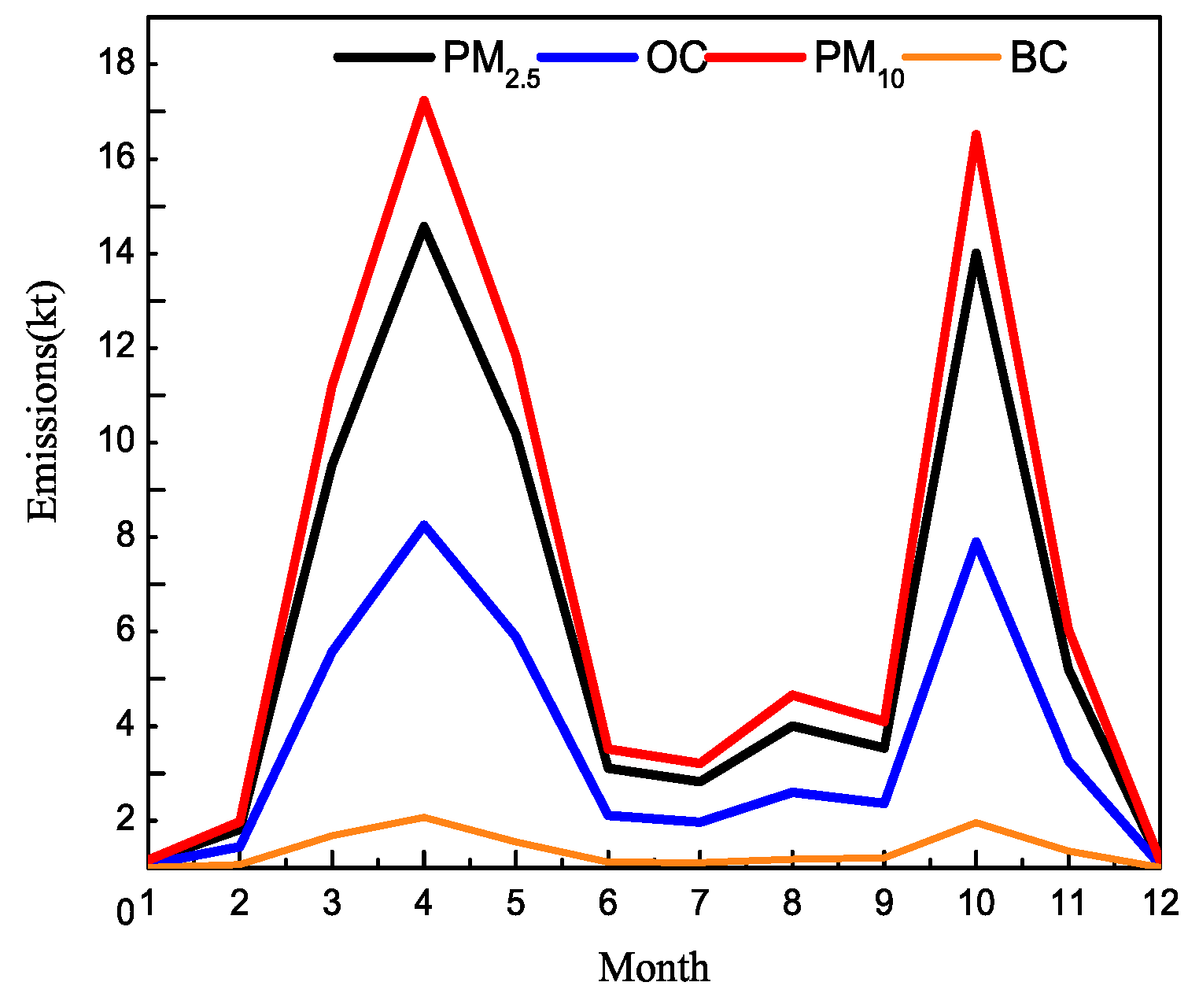
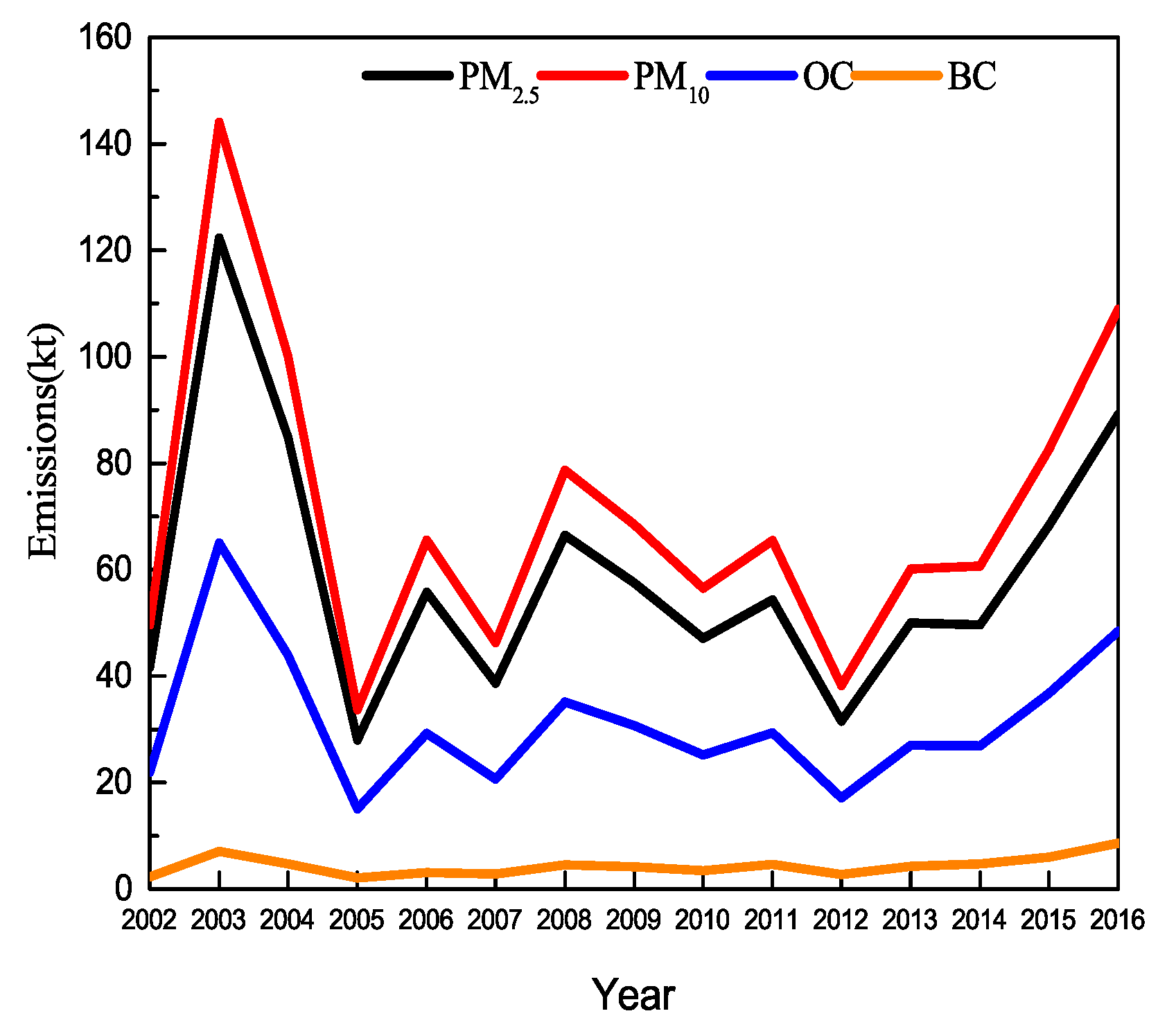
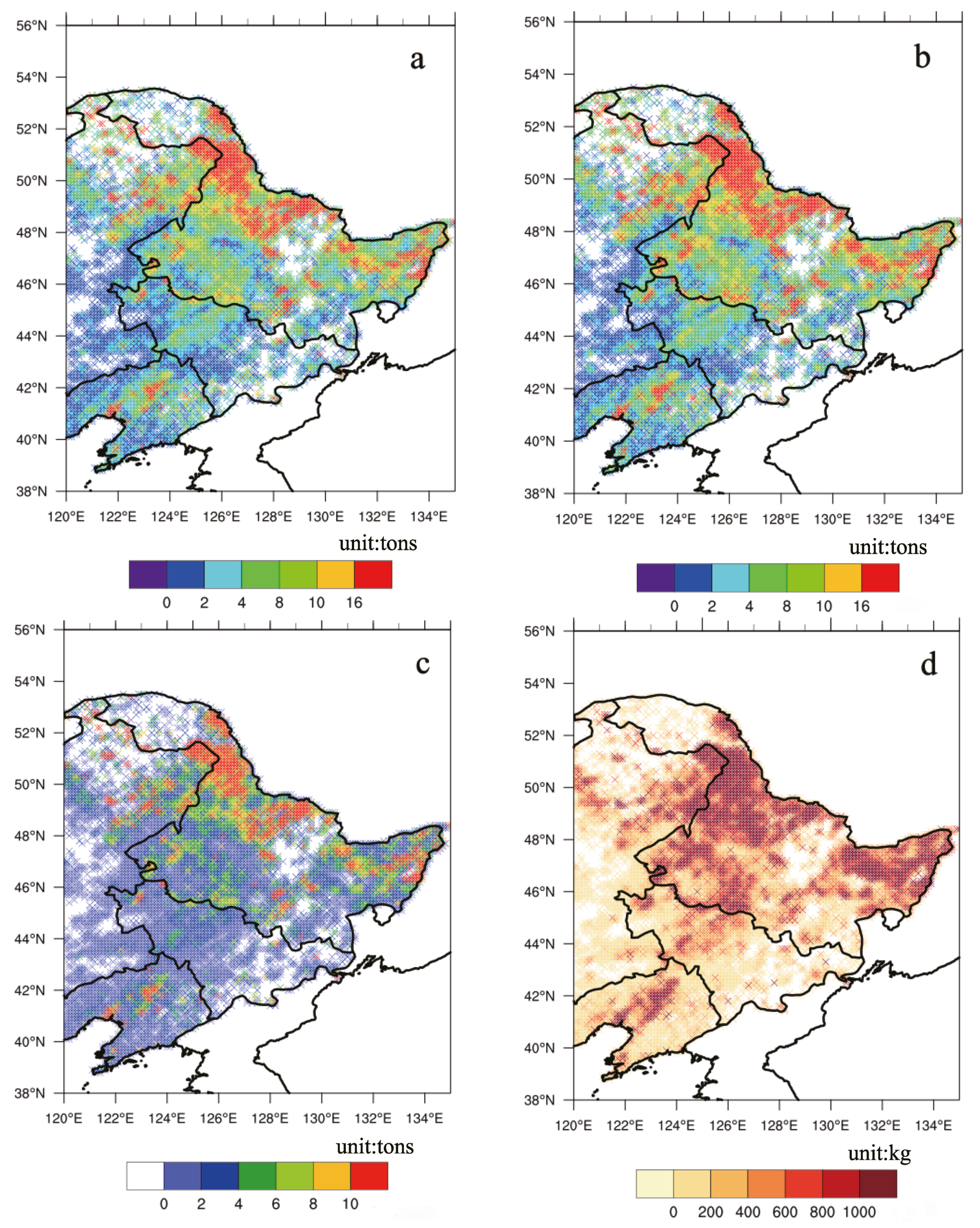
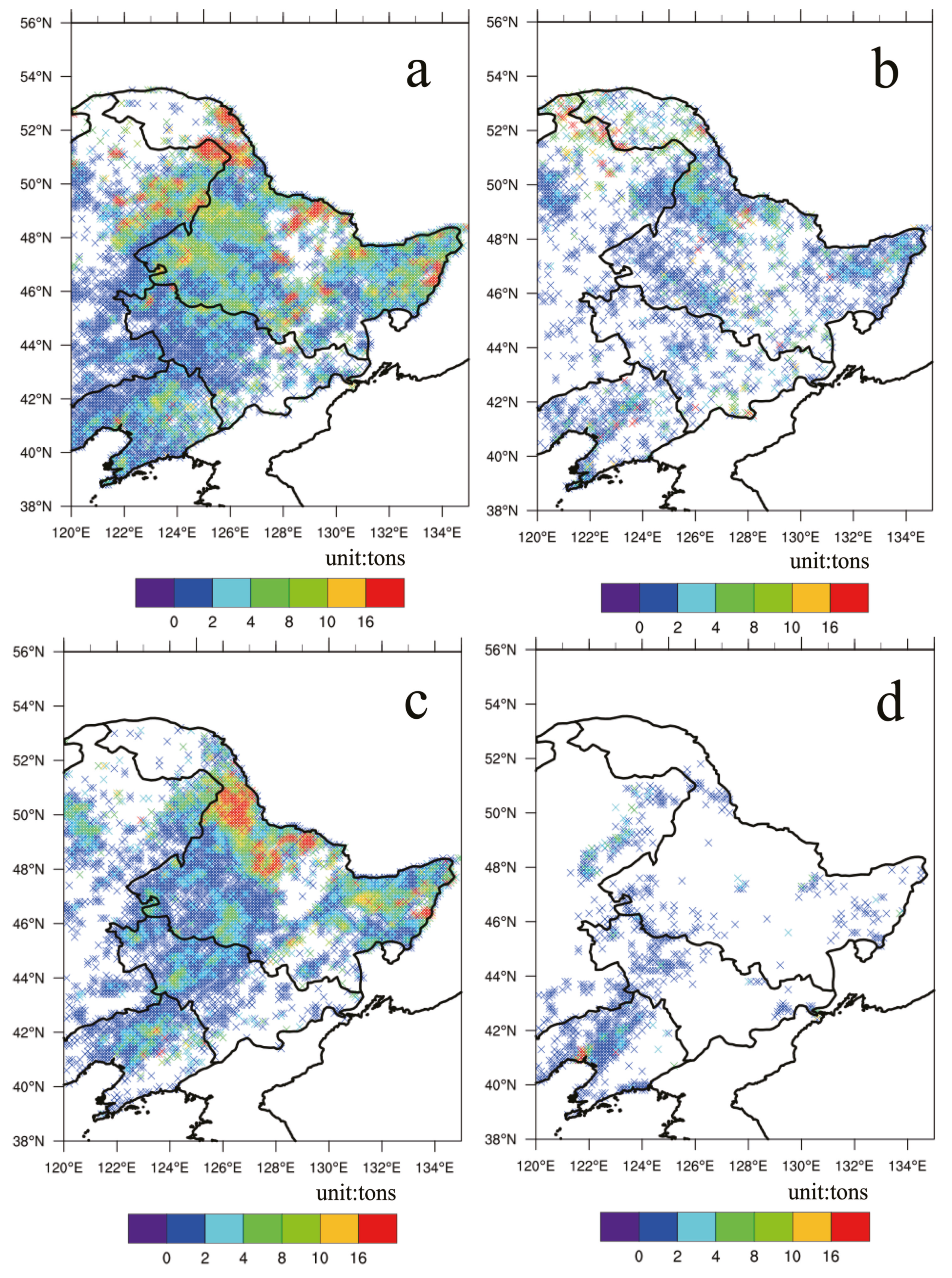
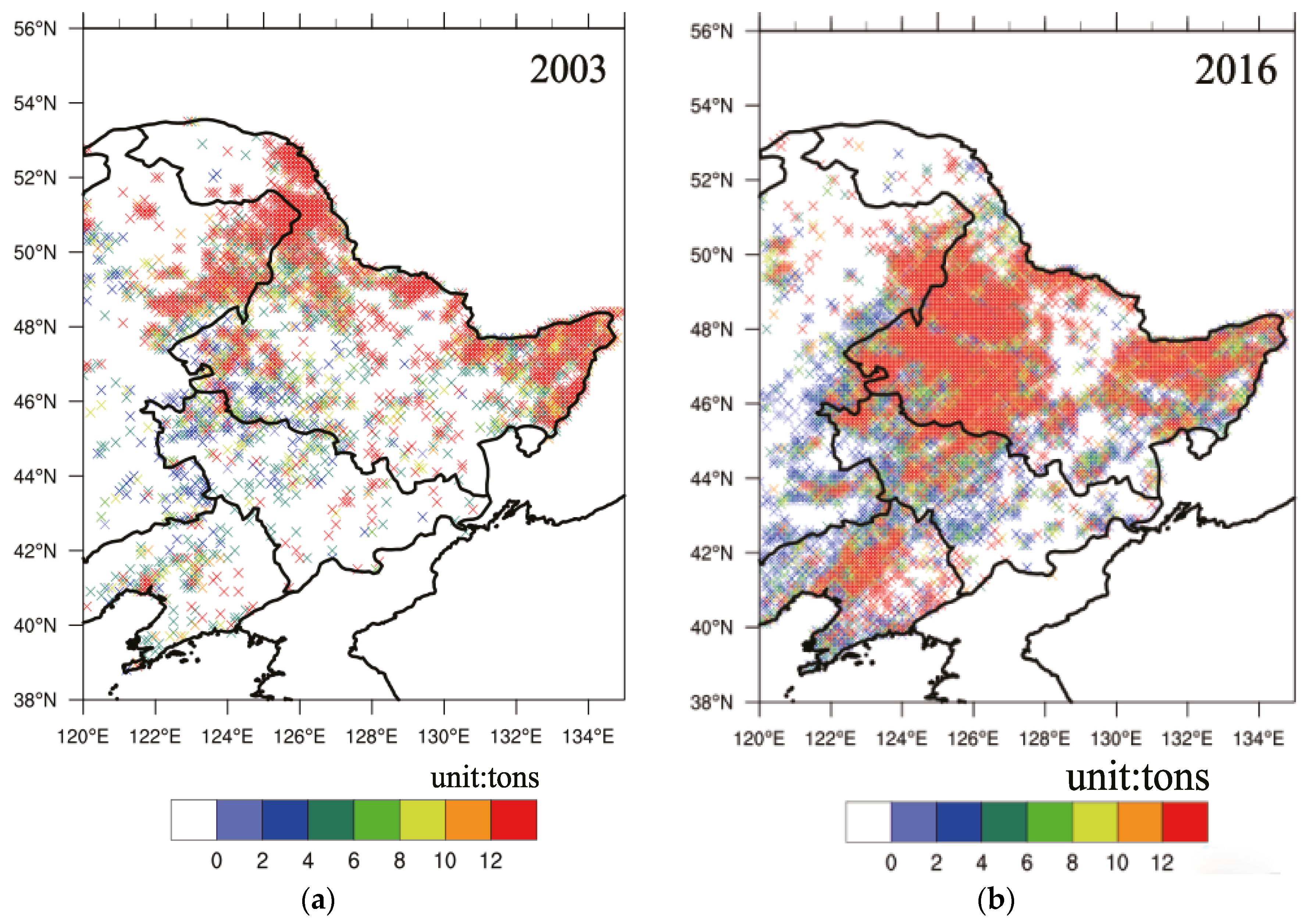
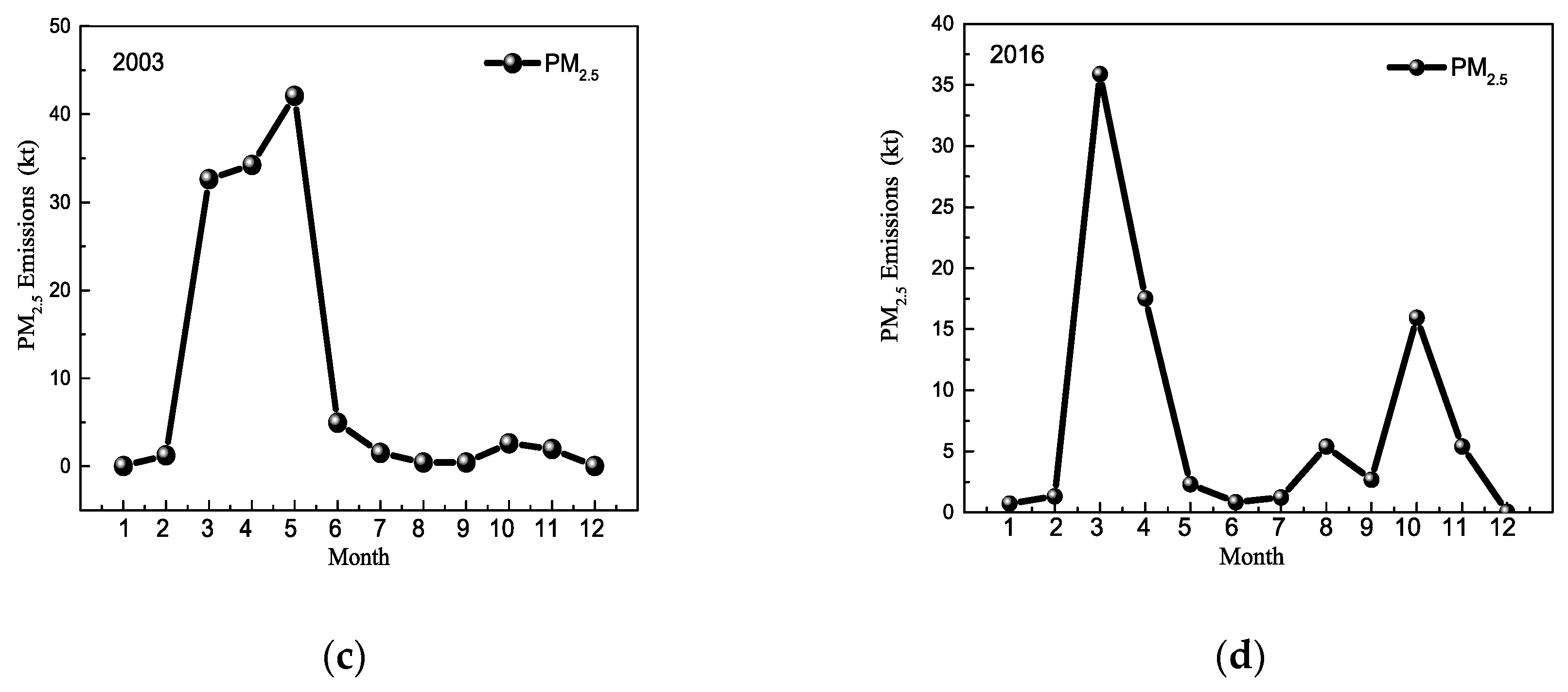
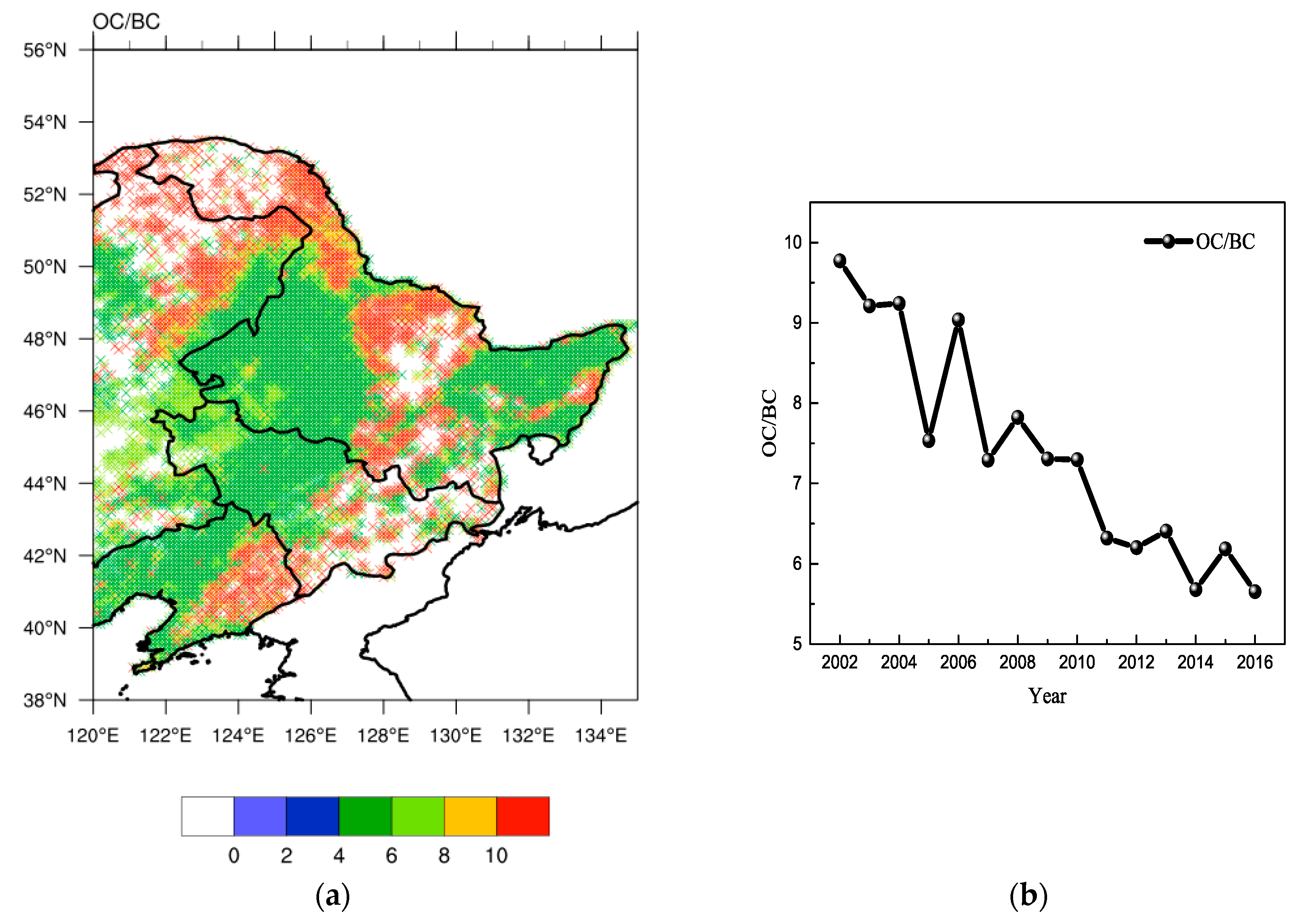
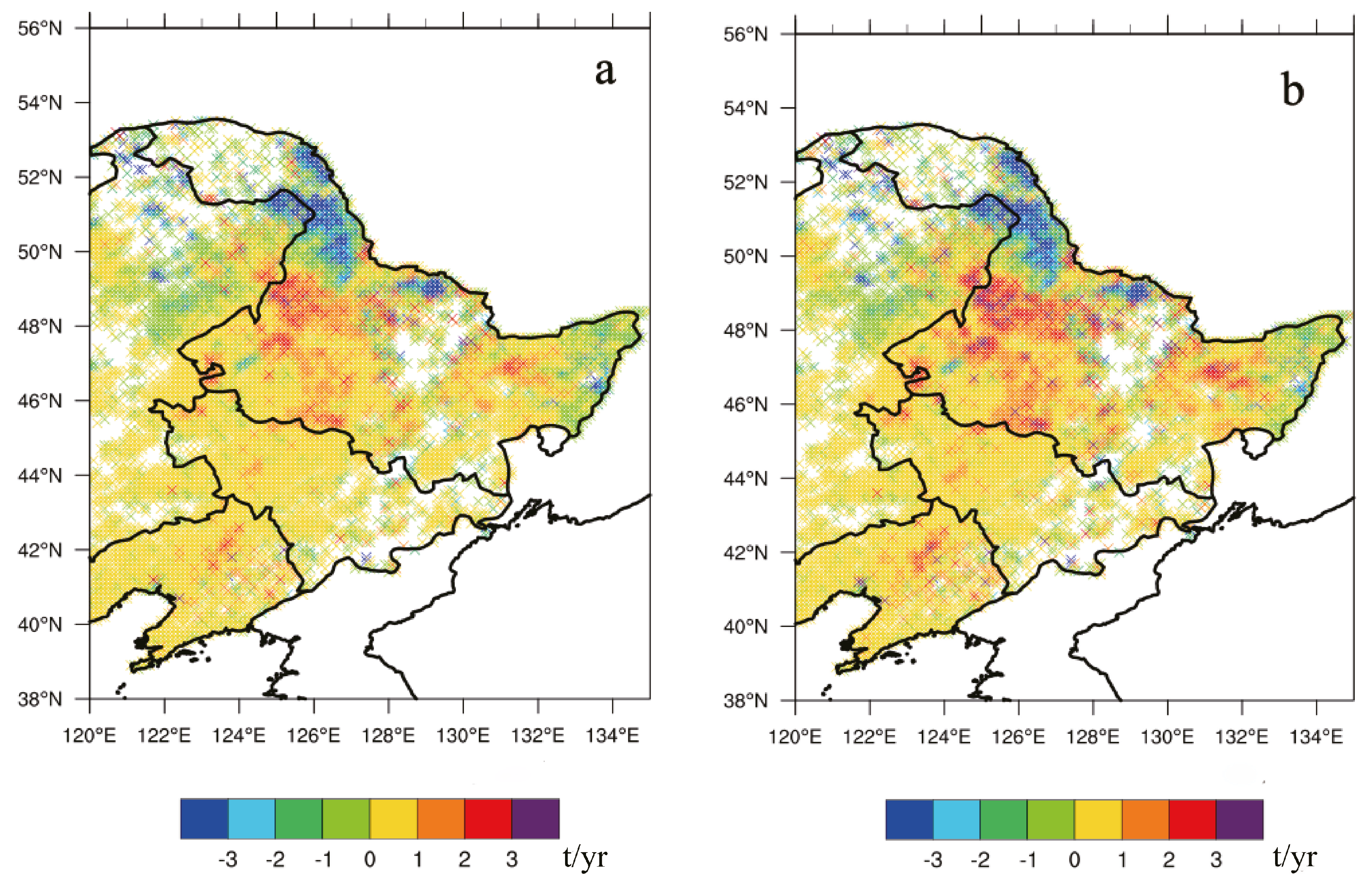
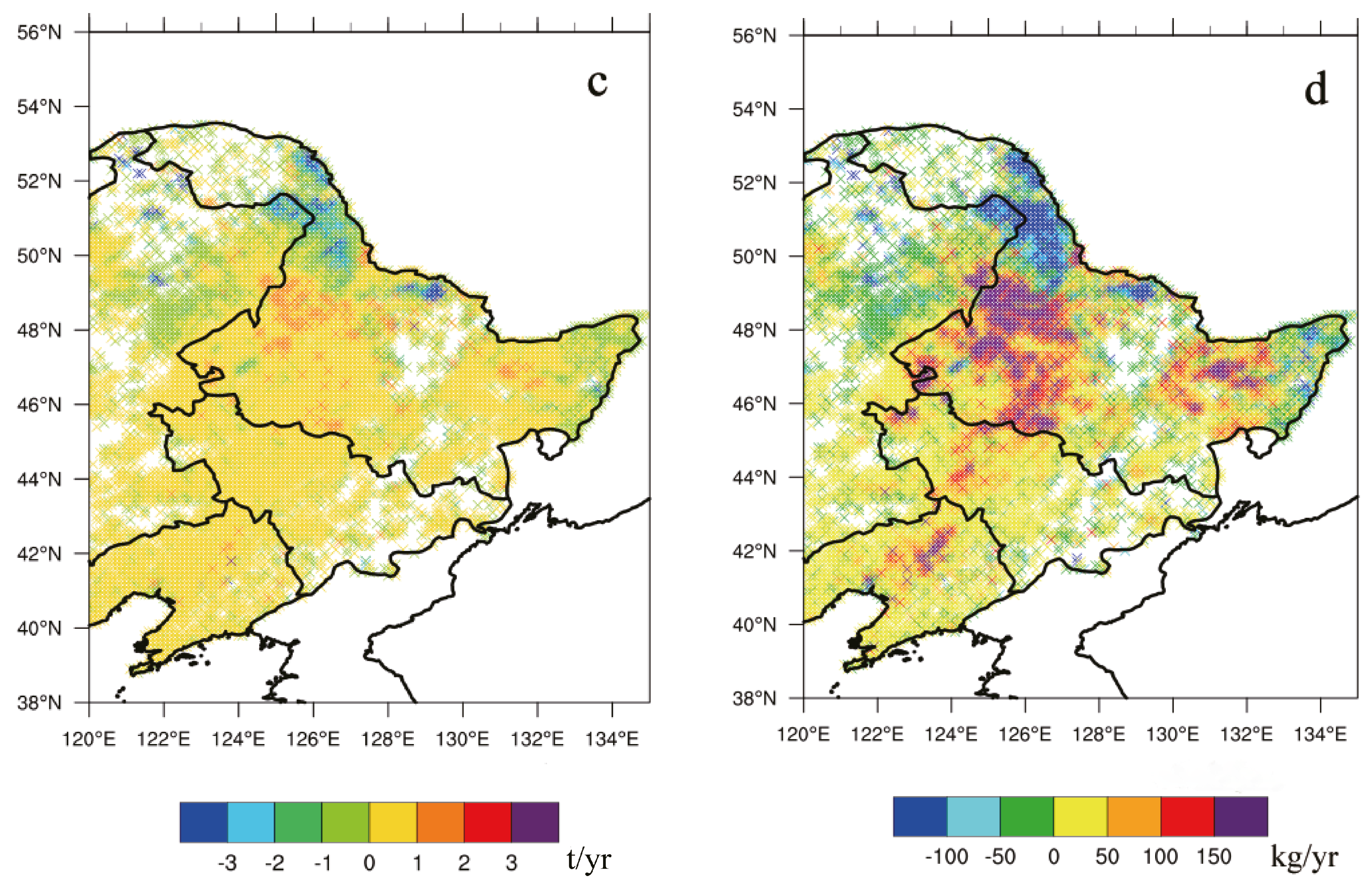
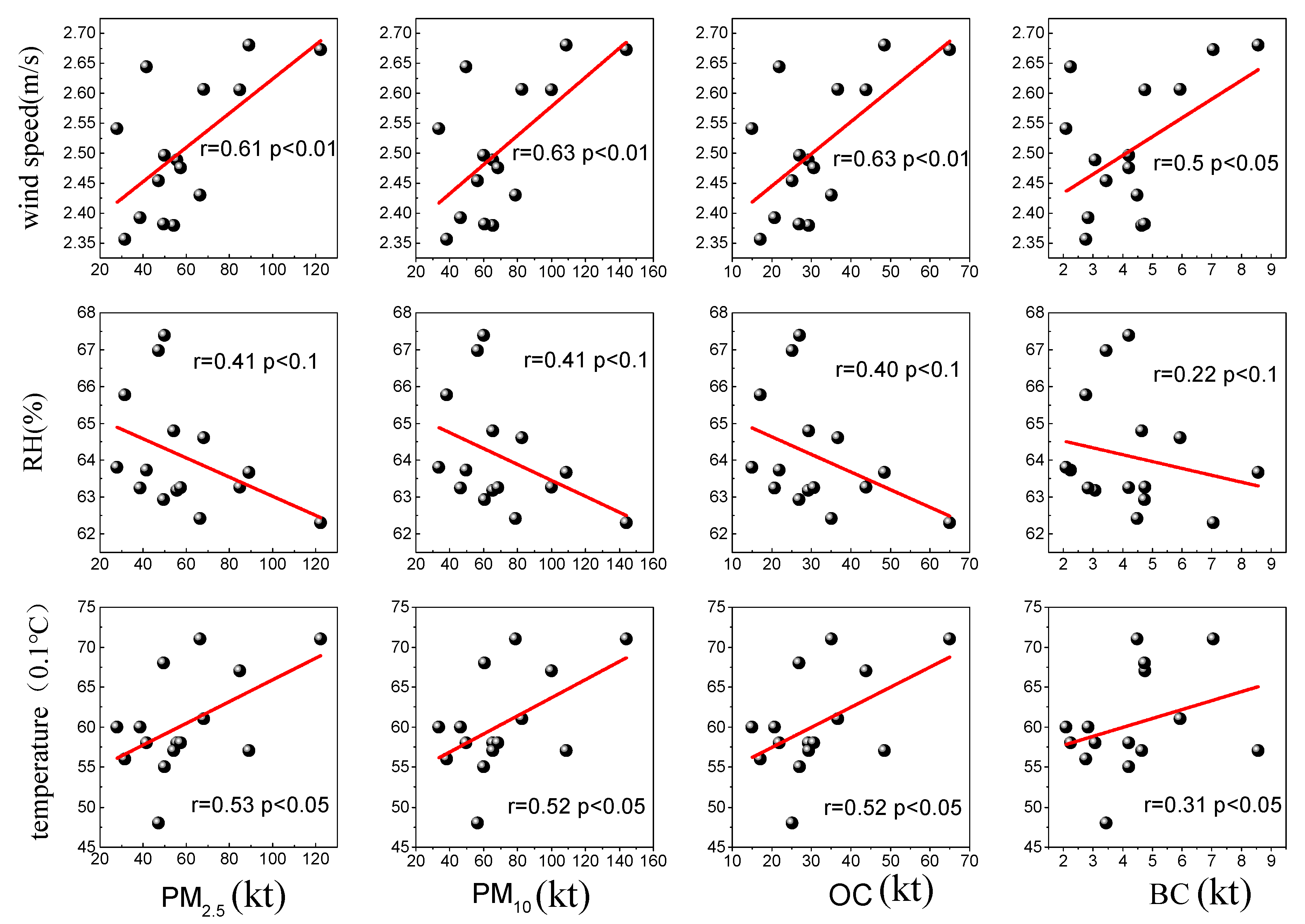
| Land-Use Types | 2000 | 2015 | Change Amounts (Rates) |
|---|---|---|---|
| Cropland | 353,028.38 | 355,938.18 | 2909.8 (0.3%) |
| Forestland | 486,735.81 | 485,266.71 | −1469.1 (−0.14%) |
| Grassland | 133,800.11 | 132,460.87 | −1339.24 (−0.12%) |
© 2018 by the authors. Licensee MDPI, Basel, Switzerland. This article is an open access article distributed under the terms and conditions of the Creative Commons Attribution (CC BY) license (http://creativecommons.org/licenses/by/4.0/).
Share and Cite
Ma, G.; Zhao, T.; Kong, S.; Bao, Y.; Chen, C.; Gong, S.; Guo, J.; Yu, C.; Wu, M.; Chang, J.; et al. Variations in FINN Emissions of Particulate Matters and Associated Carbonaceous Aerosols from Remote Sensing of Open Biomass Burning over Northeast China during 2002–2016. Sustainability 2018, 10, 3353. https://doi.org/10.3390/su10093353
Ma G, Zhao T, Kong S, Bao Y, Chen C, Gong S, Guo J, Yu C, Wu M, Chang J, et al. Variations in FINN Emissions of Particulate Matters and Associated Carbonaceous Aerosols from Remote Sensing of Open Biomass Burning over Northeast China during 2002–2016. Sustainability. 2018; 10(9):3353. https://doi.org/10.3390/su10093353
Chicago/Turabian StyleMa, Guoxu, Tianliang Zhao, Shaofei Kong, Yansong Bao, Chao Chen, Sunling Gong, Jianping Guo, Chao Yu, Ming Wu, Jiacheng Chang, and et al. 2018. "Variations in FINN Emissions of Particulate Matters and Associated Carbonaceous Aerosols from Remote Sensing of Open Biomass Burning over Northeast China during 2002–2016" Sustainability 10, no. 9: 3353. https://doi.org/10.3390/su10093353
APA StyleMa, G., Zhao, T., Kong, S., Bao, Y., Chen, C., Gong, S., Guo, J., Yu, C., Wu, M., Chang, J., & You, Y. (2018). Variations in FINN Emissions of Particulate Matters and Associated Carbonaceous Aerosols from Remote Sensing of Open Biomass Burning over Northeast China during 2002–2016. Sustainability, 10(9), 3353. https://doi.org/10.3390/su10093353








